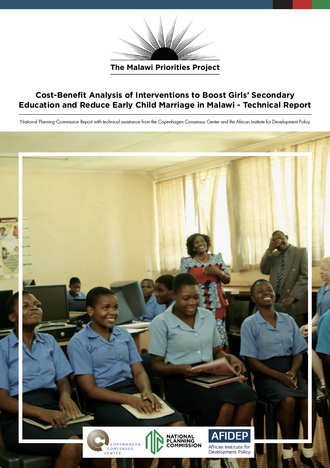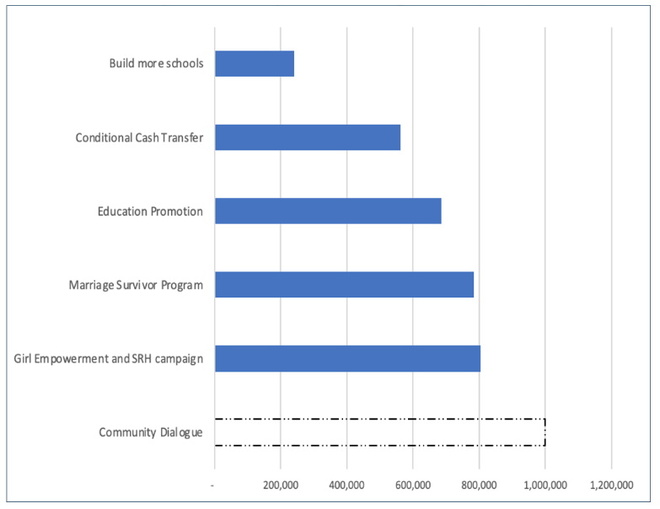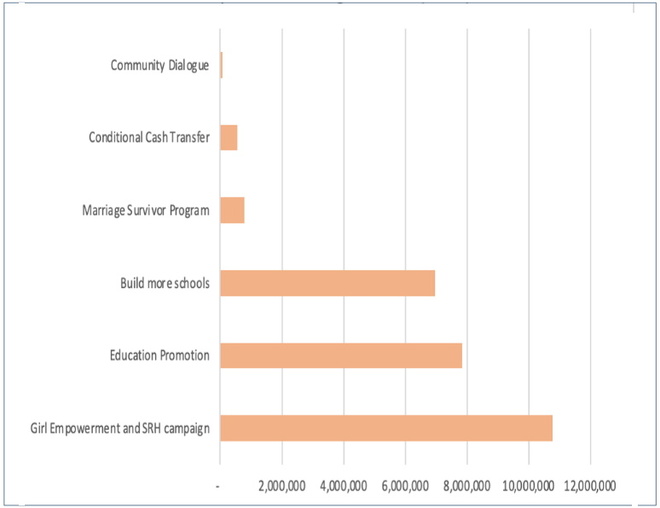Malawi Priorities: Girls' Secondary Education & Child Marriage
Technical Report
Key Messages
 In Malawi, 6 out of 7 girls are not enrolled in secondary school, while 3 out of 7 girls are married before the age of 18. Common factors drive these two startling statistics: insufficient number of secondary schools, limited labor market opportunities for girls, and cultural norms and practices that normalize early marriage.
In Malawi, 6 out of 7 girls are not enrolled in secondary school, while 3 out of 7 girls are married before the age of 18. Common factors drive these two startling statistics: insufficient number of secondary schools, limited labor market opportunities for girls, and cultural norms and practices that normalize early marriage.- Missing out on secondary school and getting married early has a number of negative effects, including earlier pregnancy, poorer health outcomes for mothers and children, increased domestic violence, and higher national fertility rates. Estimating the social and economic costs of child marriage, this report finds that each case of child marriage costs Malawian society around MWK 9 million. Specifically:
-- MWK 99,000 of social and economic costs from maternal mortality, child mortality, obstetric fistula, and intimate partner violence
-- Up to MWK 860,000 in economic costs from fewer years of education
-- MWK 8,156,000 in lower GDP per capita from increased fertility limiting demographic benefits - For every three cases of child marriage avoided, the future population of Malawi is reduced by 1 person. A potentially under-appreciated benefit of reducing child marriage, beyond the clear moral reasons, is that it can help catalyze increased economic prosperity by reducing the country’s fertility rate. This would allow women to stay in the workforce longer, boost physical capital and savings and increase investment in remaining children. Eliminating child marriage wholly supports Malawi’s wealth creation goals.
- Community dialogues to prevent child marriage are the most cost-effective intervention identified to reduce early marriage and births, requiring only MWK 69,000 to avoid a case of child marriage and MWK 200,000 to avoid a birth. This is roughly half as costly per birth avoided, as a postpartum family planning intervention identified in another paper in the Malawi Priorities series. For a program targeting 100,000 girls the annual cost of the program is MWK 755 million. This would lead to benefits in terms of improved health and lower domestic violence worth 1.4x the cost. It would generate future income per capita benefits equivalent to 112.4 times the cost of the intervention. For every Kwacha invested, this program would yield 114 in benefit.
- Malawi has already implemented Community Dialogues in response to Child Marriage, with Malawian Chiefs taking an active role in preventing or nullifying child marriage. However, there has been no formal assessment of the extent they prevent child marriage or the associated costs, key parameters for CBA. The policy recommendation is to generate and monitor relevant data from ongoing Community Dialogue efforts so that a more context-specific BCR can be calculated, to confirm that Community Dialogues are a cost-effective intervention in Malawi before scaling up nationally.
- In terms of improving secondary education attainment, the intervention that has the greatest impact per kwacha is constructing secondary schools. A program that would generate infrastructure for 100,000 more school girls every year would cost the government MWK 33.1 million in upfront infrastructure and MWK 10.2 million annually in schooling costs. Additionally, there would be a cost of MWK 24.3 million per year in lost income from going to school. While substantial initially, the costs can be spread over a long time frame, benefiting 2,000,000 girls over 20 years. The cost per year of education attained is MWK 241,000 while the annualized benefits are MWK 119,145 without including a demographic benefit. For every Kwacha invested, this program would yield 3.4 kwacha in benefit.
Context
Despite Malawi’s remarkably high enrolment rates of nearly 90% in primary school, secondary school education rates in Malawi remain chronically low, with net enrolment at 16% in 2017 (UNICEF, 2019). The issue of high school dropouts is also critically tied to child marriage, with approximately 65% of women with no formal education engaging in child marriage, and overall prevalence rates of child marriage consistently remaining more than 40% over the past decade. Despite a legal framework built to illegalize and eliminate child marriage, economic vulnerability and minimal law enforcement have resulted in the practice not only continuing but increasing remarkably in the wake of the Covid-19 pandemic.
Malawi has a serious challenge with both reducing secondary school dropouts and eliminating child marriage. Key constraints facing the nation are the lack of secondary schools and lack of labor market opportunities for Malawian girls which disincentivize investment in girls’ education. Cultural norms and practices also play a part in normalizing early marriage, teenage pregnancy, and early sexual debut. Lastly, interventions presently target different stages of a girl's life, as well as different aspects of the child marriage - secondary schooling dynamic, making it difficult to find a common comparator through which to assess effectiveness.
This Cost-Benefit Analysis attempts to provide a common ground from which to evaluate the value-for-money each of these interventions provides. As a part of this analysis, six types of interventions were compared to determine which intervention provides the strongest value-for-money. The six interventions considered were: Increased Schooling Capacity (BCR 3.4); Community Dialogues (BCR 114); Education Promotion (BCR 2.5); Conditional Cash Transfer (BCR 9.2); Marriage Survivor
Program (BCR 8.5); Girls’ Empowerment and SRH Program (BCR 9.8). Among the considered interventions, Community Dialogues generated the highest BCR with a Demographic Benefit included. Without the inclusion of a demographic benefit, however, Increased Schooling Capacity was found to be the strongest performing intervention
Value-for-Money Child Marriage Intervention: Community Dialogues
Addressing cultural norms through community dialogues was one prominent method highlighted by sector experts as important in the Malawian context. There have been several such programs already conducted such as the Chief’s Wives’ Initiative in which stations were supported with lunch allowances and fuel to engage chiefs’ wives in 8 districts on child protection issues and related laws. Given the lack of data pertaining to Malawi-based Community Dialogue programs, the paper considers a Population Council program that was implemented in three countries: Burkina Faso, Ethiopia, and Tanzania (Erulkar et al. 2017). The intervention included community sensitization on the harmful effects of child marriage and attempts to address social norms surrounding the practice. A facilitator’s guide developed to standardize messaging on the importance of girls’ education and the negative impacts of child marriage were distributed and community and religious leaders were trained at the beginning of the project to facilitate discussions and deliver messages during monthly village meetings or weekly religious services. In addition, project staff disseminated messages on market days.
Benefits of Intervention
Based on the Tanzanian rate of impact at 26% reduction in early child marriages, if run for 100,000 girls in Malawi, the program would avert 10,920 child marriages, 3,781 births, 14 maternal deaths, 77 child deaths, 12 cases of obstetric fistula, and almost 2,800 days of lost productivity from IPV per year. The welfare gains of these benefits are MWK 1,084 million, which is 1.4 times higher than the cost. However, the demographic benefit is substantial at MWK 85,883 million. The benefit-cost ratio for this intervention is 1.4 without demographic benefits or 114 with the demographic benefit. Programs that lead to fertility declines, such as those that reduce or eliminate child marriages, are likely to lead to improved economic conditions for the entire population through a variety of channels. These channels include: 1) increased fixed resources per person due to a lower population; 2) an increase in income per worker holding productivity constant but spread across fewer people 3) an increase in savings due to an increased proportion of the population of working age involved in economic activity; 4) an increase in the experience of the overall workforce as a larger proportion of workers are now older and have a work history; 5) reduction in time spent child-rearing that is reallocated to productive activities; and, 6) increased investment in children as there are now fewer children (child-quality effect).
Costs of Intervention
The costs of providing the program to cover 100,000 girls in Malawi were estimated to be MWK 755 million or about MWK 7,500 per beneficiary. The costs incurred were for the initial training of the community and religious leaders, for food and refreshments provided at monthly village meetings, and for weekly religious services. The cost of time for participants is not included as an extra cost, since they provided food and refreshments served as an incentive for participation essentially covering opportunity costs of involvement, and many of the community meetings were not additional (e.g., religious meetings that would have happened even without the intervention).
Value-for-Money Girl’s Secondary School Enrollment Intervention: Increasing the number of girls secondary schools
The intervention aims at increasing secondary schooling capacity in Malawi through the construction of additional schools, and the hiring of additional teachers. The analysis in this report is based on a program that constructs classrooms for an additional 100,000 girls per year; with an expected lifespan of these classrooms of 20 years, this program could reach a total of 2 million girls. The annualized cost is estimated at MWK 44,169 million at an 8% discount rate. Total costs of this program also include additional teacher salaries and auxiliary fees, and the foregone income from not working while at school.
Expected benefits consist mainly of an increase in school attendance and educational attainment, which translates into higher lifetime earnings. This analysis is based on the historical experience of building schools in Malawi and the impacts of additional learning on wages. The annualized benefits of the intervention over a 20-year period, covering 100,000 girls a year, were estimated to be MWK 119,145 million, made up almost entirely of increased lifetime earnings due to the additional 0.9 years of schooling. Due to the additional schooling, we also expect to avoid 4,000 child marriages, 1,370 births, 5 maternal deaths, 28 child deaths, 4 cases of obstetric fistula, and 1,012 days of lost productivity from IPV per year. The annualized demographic benefit is estimated at MWK 29.3 billion per year.
The benefit-cost ratio for this intervention comes out to 2.7. Adding the Demographic Benefit brings the BCR of this intervention to 3.4.
Figure 1: Cost per additional year of schooling attained (MWK)

Figure 2: Cost per child marriage avoided (MWK)

Summary Table: Costs and Benefits Summary for hypothetical program targeting 100,000 girls per year (10,000 girls supported for marriage survivor program)
| Build schools for girls | Community Dialogue | Education Promotion | Conditional Cash Transfer | Marriage Survivor Program | Girl Empowerment and SRH campaign | |
|---|---|---|---|---|---|---|
| Country where evidence was drawn | Malawi | Tanzania | Tanzania | Malawi | Malawi | Bangladesh |
| Cost to Government per Girl Targeted (MWK) | 66,387 | 7,549 | 13,933 | 102,741 | 539,837 | 56,028 |
| Opportunity Cost of Schooling per Girl Targeted (MWK) | 150,445 | 0 | 12,970 | 100,320 | 243,181 | 48,636 |
| Effect on Early Marriage (% drop) | -12% | -26% | -1% | -34% | -100% | -1% |
| Increase in Schooling (years per girl) | 0.90 | - | 0.05 | 0.37 | 0.90 | 0.18 |
| Cost per additional year of schooling attained (MWK) | 240,923 | Infinite | 686,302 | 580,176 | 783,018 | 805,108 |
| Cost per child marriage avoided (MWK) | 6,960,083 | 69,133 | 7,843,447 | 561,537 | 783,018 | 10,776,215 |
| Cost per birth avoided (MWK) | 20,102,513 | 199,675 | 22,653,896 | 2,778,618 | 3,185,290 | 2,776,233 |
| Total Annualized Cost (millions MWK) | 44,169 | 755 | 3,294 | 20,306 | 7,830 | 10,466 |
| Total Annualized Benefit (millions MWK), non-demographic benefits | 119,145 | 1,084 | 4,901 | 20,306 | 10,726 | 16,708 |
| Total Annualized Demographic Benefits (MWK millions) | 29,327 | 85,883 | 3,304 | 165,981 | 55,842 | 85,637 |
| BCR without demographic benefit | 2.7 | 1.4 | 1.5 | 1.0 | 1.4 | 1.6 |
| BCR with the demographic benefit | 3.4 | 114 | 2.5 | 9.2 | 8.5 | 9.8 |
Note: BCRs are based on costs and benefits discounted at 8% (see accompanying technical report). BCR ratings are determined on the following scale Excellent, BCR > 15; Good, BCR 5-15; Fair, BCR 1-5; Poor, BCR < 1. This traffic light scale was developed by an Eminent Panel including several Nobel Laureate economists for a previous Copenhagen Consensus project that assessed the Sustainable Development Goals.
Download the full policy brief here.

